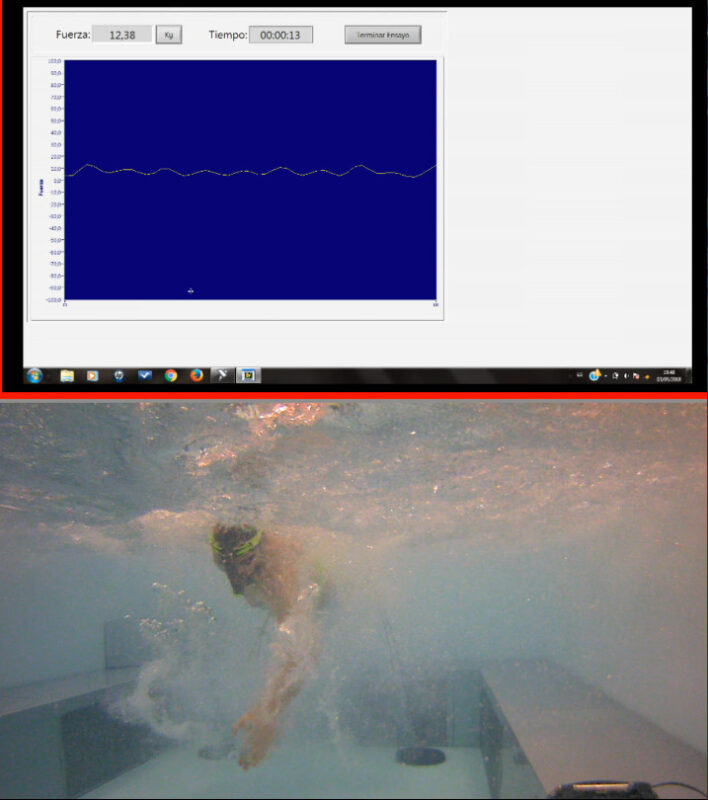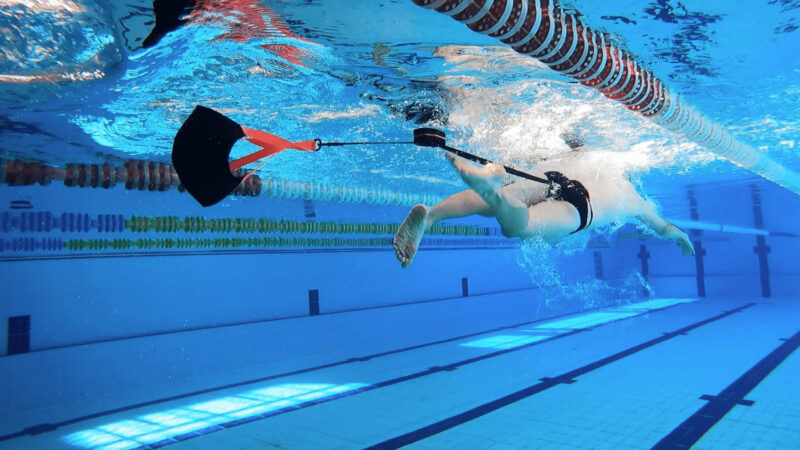Introduction and methodology:
Muscular force production while stroking is determinant in competitive swimming performance (Keskinen, Tilli, & Komi, 1989). As a consequence of this fact, some authors have sought a relationship between swimming performance and multi-joint dry-land exercises involving the same muscle system required in swimming (Morouço et al., 2011; Perez-olea, Valenzuela, Aponte, & Izquierdo, 2018). However, the environmental conditions of these exercises are different from those experienced by swimmers in the water (Ravé et al., 2018). Hence, tethered swimming was one of the methodologies used to the measurement of force, being stated as a valid and reliable methodology to assess swimmer’s strength potential (Akis & Orcan, 2004; Amaro, Marinho, Batalha, Marques, & Morouço, 2014). During tethered swimming the force is measured through a transducer fixed to the wall and connected to swimmers’ hip by a non-elastic.
The aquatic environment complicates the direct measurement of force application (Akis & Orcan, 2004), resulting in kinematical differences between free-swimming and tethered swimming (Samson, Monnet, Bernard, Lacouture, & David, 2018). These differences are due to the stationary water and the nondisplacement of the swimmers. Hence, the use of a flume was indicated as a way to replicate the conditions experienced during free-swimming (Vorontsov, Popov, Binevsky, & Dyrko, 2006). Thus, in our Aquatics Lab, we studied the relationship between tethered swimming in a flume and free-swimming performance. We found stronger relationships between tethered force parameters and swimming performance as the water flow velocity increased (Ruiz-Navarro, Morouço, & Arellano, 2020). The fact that the relationship between tethered force parameters and swimming velocity increased as the water flow approached the actual free-swimming velocity seemed to evaluate the ability to apply force in the water. Meanwhile, at zero velocity it appeared to measure the muscle strength potential of the swimmer (Ruiz-Navarro et al., 2020; Vorontsov et al., 2006).

Unfortunately, not many clubs can afford the cost of a swimming flume, so other options have been considered. Semi-tethered swimming became an alternative, as it allows swimmers´ displacement while force production is registered. In addition, the 25 m swim speed was shown to be strongly correlated with maximum swim power (Dominguez-Castells, Izquierdo, & Arellano, 2013). Furthermore, semi-tethered swimming has been used as a method for power-strength in-water development through the use of power-racks, elastic cords, or parachutes. Nevertheless, when implementing these methods, high loads alter the kinematics of swimming (Cuenca-Fernández, Gay, Ruiz-Navarro, & Arellano, 2020), which produces a deterioration in swimming patterns that might be counterproductive and result in a worsening of swimming performance (Francisco Cuenca-Fernández, Ruiz-Navarro, & Arellano, 2020).
Applications for coaches
Tethered swimming is a useful tool for swimming assessment and training. The use of a flume allows overcoming the differences between free-swimming and tethered swimming, evaluating the ability to apply force in the water. Subsequently, semi-tethered swimming can be also used as an alternative to tethered swimming. This methodology is often used in daily training for in-water strength and power development. However, coaches shall be cautious about applying high loads, as it can alter the swimming kinematics. Therefore, swimmers should focus on the strength and power development with the proper technique (i.e., the same technique as they will use while free-swimming).
Original version of the study
Ruiz-Navarro, J. J., Morouço, P. G., & Arellano, R. (2020). Relationship between tethered swimming in a flume and swimming performance. International journal of sports physiology and performance, 15(8), 1087-1094. https://doi.org/10.1123/ijspp.2019-0466
Cuenca-Fernández, F., Gay, A., Ruiz-Navarro, J. J., & Arellano, R. (2020). The effect of different loads on semi-tethered swimming and its relationship with dry-land performance variables. International Journal of Performance Analysis in Sport. https://doi.org/10.1080/24748668.2020.1714413
Cuenca-Fernández, F., Ruiz-Navarro, J. J., & Arellano, R. (2020). Strength-velocity relationship of resisted swimming: A regression analysis. In ISBS Proceedings Archive (pp. 388–391).
Acknowledgments
These studies were supported by grants awarded by the Ministry of Science, Innovation, and Universities (Spanish Agency of Research) and the European Regional Development Fund (ERDF): DEP2014-59707-P ‘SWIM: specific water innovative measurements applied to the development of the international swimmers in short swimming events (50 and 100 m)’, the Ministry of Science, Innovation, and Universities (Spanish Agency of Research) and the European Regional Development Fund (ERDF); PGC2018-102116-B-I00 ‘SWIM II: Specific Water Innovative Measurements: Applied to the performance improvement’ and the Spanish Ministry of Education, Culture and Sport: FPU17/02761 grant.
References
Akis, T., & Orcan, Y. (2004). Experimental and analytical investigation of the mechanics of crawl stroke swimming. Mechanics Research Communications, 31(2), 243–261. https://doi.org/10.1016/j.mechrescom.2003.07.001
Amaro, N., Marinho, D. A., Batalha, N., Marques, M. C., & Morouço, P. (2014). Reliability of tethered swimming evaluation in age group swimmers. Journal of Human Kinetics, 41(1), 155–162. https://doi.org/10.2478/hukin-2014-0043
Cuenca-Fernández, F, Gay, A., Ruiz-Navarro, J. J., & Arellano, R. (2020). The effect of different loads on semi-tethered swimming and its relationship with dry-land performance variables. International Journal of Performance Analysis in Sport. https://doi.org/10.1080/24748668.2020.1714413
Cuenca-Fernández, Francisco, Ruiz-Navarro, J. J., & Arellano, R. (2020). Strength-velocity relationship of resisted swimming: A regression analysis. In ISBS Proceedings Archive (pp. 388–391).
Dominguez-Castells, R., Izquierdo, M., & Arellano, R. (2013). An updated protocol to assess arm swimming power in front crawl. International Journal of Sports Medicine, 34(4), 324–329. https://doi.org/10.1055/s-0032-1323721
Keskinen, K. L., Tilli, L. J., & Komi, P. V. (1989). Maximum velocity swimming: Interrelationships of stroking characteristics, force production and anthropometric variables. Scand J Sport Sci, 11, 87-92.
Morouço, P., Neiva, H., González-Badillo, J., Garrido, N., Marinho, D., & Marques, M. (2011). Associations between dry land strength and power measurements with swimming performance in elite athletes: a pilot study. Journal of Human Kinetics, 29A(Special Issue). https://doi.org/10.2478/v10078-011-0065-2
Perez-olea, J. I., Valenzuela, P. L., Aponte, C., & Izquierdo, M. (2018). Relationship between dryland strength and swimming performance: pull-up mechanics as a predictor of swimming speed. Journal of Strength and Conditioning Research, 32(6), 1637–1642.
Ravé, J. M. G., Lega-Rrese, A., González-Mohíno, F., Yustres, I., Barragán, R., De Asís Fernández, F., … Arroyo-Toledo, J. J. (2018). The Effects of Two Different Resisted Swim Training Load Protocols on Swimming Strength and Performance. Journal of Human Kinetics, 64(1), 195–204. https://doi.org/10.1515/hukin-2017-0194
Ruiz-Navarro, J. J., Morouço, P. G., & Arellano, R. (2020). Relationship Between Tethered Swimming in a Flume and Swimming Performance. International Journal of Sports Physiology and Performance, 15(8), 1087–1094. https://doi.org/https://doi.org/10.1123/ijspp.2019-0466
Samson, M., Monnet, T., Bernard, A., Lacouture, P., & David, L. (2018). Comparative study between fully tethered and free swimming at different paces of swimming in front crawl. Sports Biomechanics, 1–16. https://doi.org/10.1080/14763141.2018.1443492
Vorontsov, A., Popov, O., Binevsky, D., & Dyrko, V. (2006). The assessment of specific strength in well trained male athletes during tethered swimming in the swimming flume. Revista Portuguesa de Ciências Do Desporto, 275–277.

Leave a Reply